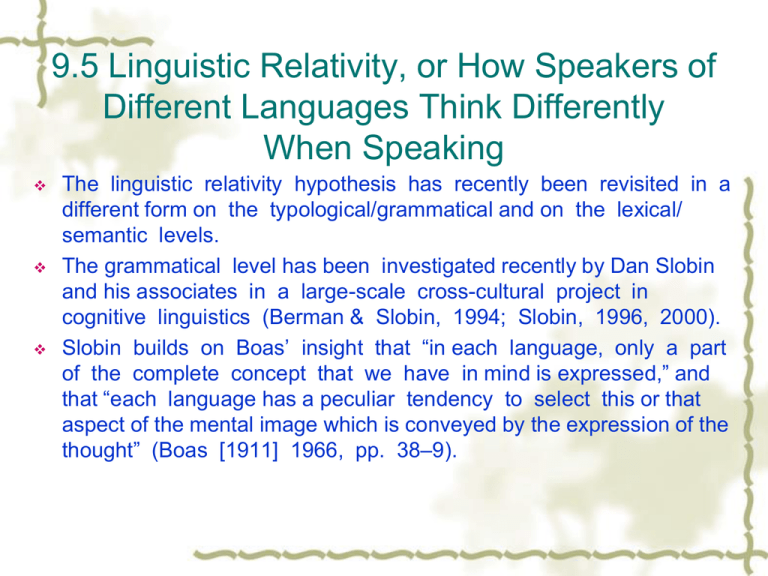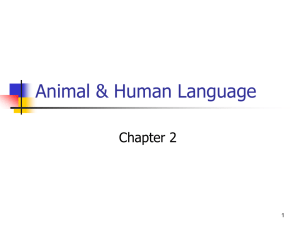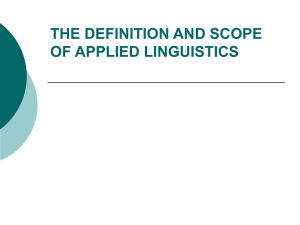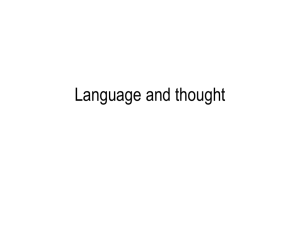Contextualization cues
advertisement

9.5 Linguistic Relativity, or How Speakers of Different Languages Think Differently When Speaking The linguistic relativity hypothesis has recently been revisited in a different form on the typological/grammatical and on the lexical/ semantic levels. The grammatical level has been investigated recently by Dan Slobin and his associates in a large-scale cross-cultural project in cognitive linguistics (Berman & Slobin, 1994; Slobin, 1996, 2000). Slobin builds on Boas’ insight that “in each language, only a part of the complete concept that we have in mind is expressed,” and that “each language has a peculiar tendency to select this or that aspect of the mental image which is conveyed by the expression of the thought” (Boas [1911] 1966, pp. 38–9). Slobin calls languages like English, German, or Dutch, satelliteframed languages (or S-languages), because motion path is given by a satellite to the verb – in English, a verb particle – while manner is bundled up with the verb. By contrast, languages like French, Spanish, or Turkish are verbframed (or V-languages) because motion path is indicated by the main verb in a clause – verbs like ‘enter’, ‘exit’, ‘cross’, and manner is expressed by adding an element or phrase to the sentence (Slobin, 2000, p. 112). What does this tell us about the way these speakers think? Slobin (2000) claims that The semantic level of linguistic relativity has been explored recently most systematically by Anna Wierzbicka (1992). She too is inspired by von Humboldt and Sapir/Whorf as she searches for a natural semantic metalanguage that could explain conceptual differences among languages, since “it is impossible for a human being to study anything – be it cultures, language, animals, or stones – from a totally extra-cultural point of view.” She tries to identify “universal semantic primitives out of which thoughts and complex concepts are constructed and in terms of which all complex concepts [and the culture-specific aspects of meaning] in any language can be explained” (1992, p. 25). For example she compares concepts like Russian dusha or serdce, German Seele, and English soul, mind or heart by exploring their associative networks and their connotations, and by decomposing each concept into parts whose names have simple English equivalents. 9.6 Discursive Relativity, or How Speakers of Different Discourses (across Languages or in the Same Language) Have Different Cultural Worldviews The idea that “verbal discursive practices affect some aspects of thinking either by modulating structural influences or by directly influencing the interpretation of the interactional context” (Lucy, 2000, p. x) underlies much recent research in linguistic anthropology, language socialization studies, and cultural psychology, as mentioned in Section 9.3. This kind of research draws not on rationalist theories of mind, but on theories that account for the interaction of mind, language, and social/cultural action in communicative practices of everyday life. Parallel to the work of Lakoff and Johnson in cognitive linguistics, and following along the lines of Malinowski and Boas, John Gumperz has shown the importance of contextualization cues to make sense of what is going on in conversation (Gumperz, 1992, p. 231). Contextualization cues are those features of speech that “relate what is said at any one time and in any one place to knowledge acquired through past experience, in order to retrieve the presuppositions [participants] must rely on to maintain conversational involvement and assess what is intended” (1992, p. 230). 9.7 Language Relativity in Applied Linguistic Research Research on all three forms of language relativity has been carried out pretty much independently of research on second language acquisition (SLA), which forms a large area of the field called “applied linguistics.” The brief survey that follows recapitulates the history of SLA research from the perspective of language relativity. Prior to the emergence of applied linguistics in the late fifties/early sixties, the combination of structural linguistics and behavioral psychology led to contrastive analysis approaches in language acquisition study and to behavioristic methods of language teaching (repetition, habit formation, translation). The first cognitive revolution in educational psychology brought about by Jerome Bruner and his colleagues in the fifties reinstated the autonomy of the thinking subject (Bruner, Goodnow, & Austin, 1956), at the same time as the linguistic revolution brought about by Noam Chomsky (1957) reinstated the autonomy of the speaking-hearing subject, thus liberating the learner from behavioral conditioning and political manipulation. Both western psychology and linguistics have implicitly adopted the rationalist, Cartesian view that language reflects thought and thought is expressed through language, but also that psychological processes exist independently of language and of the social activities in which language is used. Through the eighties, SLA research was not interested in linguistic relativity. The classical texts in the field (Ellis, 1986; Spolsky, 1989; Larsen-Freeman & Long, 1991; Lightbown & Spada, 1993; V. Cook, 1993) don’t even mention the concept. Researchers within the formal linguistic tradition sought to discover universal aspects of second language (L2) acquisition based on the principles of Universal Grammar and its language-specific parameters, or on universally valid psycholinguistic processes of L2 development. Researchers within the functionalist tradition of SLA sought to discover L2-specific rules of communicative competence including the deployment of communicative strategies and the management of conversations in social contexts. Researchers within the pragmatics strand of SLA explored the realization of speech acts across languages. In neither of these cases was language relativity on the agenda. Although SLA research was concerned with the social context of language learning (see e.g., Ellis, 1987), it viewed the social as a stable, pre-existing fixture, existing outside the individual, not constructed by an individual’s psychological and linguistic processes. By relying on the standard (national) native speaker as a benchmark for language acquisition, it seemed to equate, like Herder and von Humboldt, one language with one national community and one national culture. This is particularly noticeable in interlanguage pragmatics (Kasper & Rose, 2001), which investigates the realization of speech acts across “cultures.” For researchers in this area of applied linguistics, a speaker of Japanese or Hebrew is seen as a representative of “the” Japanese or Israeli national culture. “Culture” is most of the time essentialized into monolithic national cultures on the model of monolithic standard national languages. Such a synchronic mapping of language onto culture seems unduly deterministic, even though it is explained by its different research tradition. It is also noticeable in the area of contrastive rhetoric, that still influences much of ELT today (see Section 9.9 below). The overwhelming focus of SLA research on the (standard) linguistic aspects of communicative competence and the (universal) cognitive aspects of learning, as well as its inability to deal satisfactorily with social and cultural variation, foreclosed any possibility of taking into consideration semiotic, linguistic, and discursive relativity in language development. What has been missing is a consideration of the historical dimension of the relation of language, thought, and culture – a dimension that sociocultural approaches to SLA have brought back into the equation by taking a historically and socially relativistic perspective on language development. The social and cultural turn in SLA within the last ten years (e.g., Kramsch, 1993; Lantolf, 2000) has made the language relativity principle more relevant in applied linguistics. It is implicit in recent environmental or ecological theories of SLA (e.g., Larsen-Freeman, 2002; Lemke, 2002; van Lier, 2000), and in the return of a phenomenological tradition of inquiry (Kramsch, 2002a). It can be seen in language socialization research, in sociolinguistic strands of applied linguistics (e.g., Rampton, 1997), and in neo-Whorfian perspectives on bi- and multilingualism (Pavlenko, in press), The seeds are now there to deal with individual, social, and cultural variation within SLA research. Efforts to eschew rigid dichotomies like input vs. output, acquisition vs. learning, and to replace them by more holistic concepts like affordances, collaborative dialogue, or mediated activity leave open the possibility of placing language relativity at the core of language acquisition and use (Lantolf, 2000). So does the recent emphasis on creativity and play in language development (Cook, 2000), ritual and symbolic interaction (Rampton, 2002) and on the conceptual and subjective make up of multilingual speakers and learners (Pavlenko, 1999; Kramsch, forthcoming). Interest in language relativity can also be found in the increased attention devoted in linguistic anthropology to verbal art, poetic patterning, and the “poetic imagination.” All these recent developments focus on the way individual and collective thoughts and sensibilities are co-constructed, shaped, and subverted through language as communicative and representational practice. From a methodological perspective, the principle of language relativity suggests adopting an ecological/phenomenological approach to research in applied linguistics (Kramsch, 2002b). As such it is both inspirational and risky. Because it enables applied linguists to recapture the early holistic view of language, thought, and culture envisaged by Boas and Sapir, it feels more valid than positivistically oriented research approaches that have to reduce the evidence to what is rationally researchable. On the other hand, it might be much less reliable, if by reliable we mean evidence that can be replicated to support universal claims to truth. However, the research reviewed above shows that it is possible to relate language to thought and culture in ways that adhere to the criteria of sound and rigorous research in the social sciences, especially in cognitive linguistics and linguistic anthropology. 9.8 Language Relativity in Educational Practice The critical test of applied linguistics as a research field is, of course, education, in the broadest sense of the bringing about of social and cultural change. Henry Widdowson pointed to this problem when he wrote: “It is the responsibility of applied linguists to consider the criteria for an educationally relevant approach to language” (1980, p. 86). But what is “educationally relevant”? Jerome Bruner answers: The needs of the culture, as perceived and formulated by teachers, school administrators, and textbook writers and publishers may not be the same as those formulated by researchers, nor is the discourse of all practitioners or of all researchers homogeneous. Culture, in an individual, as in society at large, is plural, changing, and often conflictual. The problem here is the conflict between the desire of the practitioner and the constraints of the institution, e.g., between the culture of teaching and the culture of testing, or between the culture of the students and the culture of native speakers. The conflict is expressed in three questions that can be raised by the principle of language relativity in educational linguistics. First, isn’t applied linguistic theory itself subjected to the principle of language relativity? Second, isn’t educational culture inherently inhospitable to the principle of language relativity, since its ultimate goal is to discriminate between educated and non-educated segments of the population through the imposition of the same formal norms to everyone? Third, can language relativity be taught directly or can it only be modelled? 9.9 The Danger of Stereotyping and Prejudice However attractive the notion of language relativity might be for research, (even though it poses problems of methodology), it is not without risks when used in educational practice. In an influential essay on cross-cultural rhetoric, Robert Kaplan, 30 years ago, advanced the theory that speakers of different languages write according to different rhetorical logics. Kaplan’s views echo those of Sapir and Whorf: It is easy to see why so many ESL (English as a second language) teachers of writing extrapolated from the nature of the students’ native language to the logic of their paragraphs, and, from there, to the innate logic of their minds and the intrinsic nature of their characters. Even though this was of course not what Kaplan had intended, many believed that Americans were direct and straightforward, Chinese devious and roundabout, and the French illogical and untrustworthy, and that those qualities were the direct result of the language they spoke. Kaplan did later disavow these undue extrapolations (1987), but he still aintained his original position that “the acquisition of a second language ally requires the simultaneous acquisition of a whole new universe and a hole new way of looking at it” (1972, p. 100). 9.10 Instead of Language-Thought-and-Culture: Speakers/Writers, Thinkers, and Members of Discourse Communities As we have seen, the principle of language relativity shifts the focus away from static concepts like language, thought, and culture toward more dynamic notions of speakers/writers, thinkers, and members of discourse communities. Language is only one of many semiotic systems with which learners make sense of the world expressed in a different language. The acquisition of another language is not an act of disembodied cognition, but is the situated, spatially and temporally anchored, co-construction of meaning between teachers and learners who each carry with them their own history of experience with language and communication. Culture is not one worldview, shared by all the members of a national speech community; it is multifarious, changing, and, more often than not, conflictual. Language relativity suggests reorienting the focus of language teachers from what they do to who they are. When considering the implications of language relativity for educational practice, it is important to make the difference between language relativity and moral relativism. It is not because we can no longer uphold universal values that our language would impose on speakers of other languages that we are no longer entitled to the values that our language both creates and reflects. The principle of language relativity enables us to understand to a certain degree how speakers of other languages think and what they value. It does not mean that it obliges us to agree with or to condone these values. But it does commit us to “see ourselves amongst others, as a local example of the forms human life has locally taken, a case among cases, a world among worlds, [a view] without which objectivity is selfcongratulation and tolerance a sham” (Geertz, 1983, p. 16). 9.11 Conclusion: The “Incorrigible Diversity” of Applied Linguistics This essay has drawn on several disciplines besides linguistics, such as psychology, sociology, and anthropology and new crossdisciplinary fields like cognitive linguistics, cultural psychology, linguistic anthropology, to illuminate the relationship of language, thought, and culture in applied linguistics. The question arises as to whether the field is done a service or a disservice by becoming “hybridized” to such an extent. Not every applied linguist agrees that it is a good thing for applied linguistics to draw on so many feeder disciplines without the possibility of developing a unified applied linguistic theory. Yet, it seems that research on language as cognitive, social, and cultural practice cannot but draw on a multiplicity of disciplines, even though it does not make the methodology of applied linguistics research any easier. Thanks!







